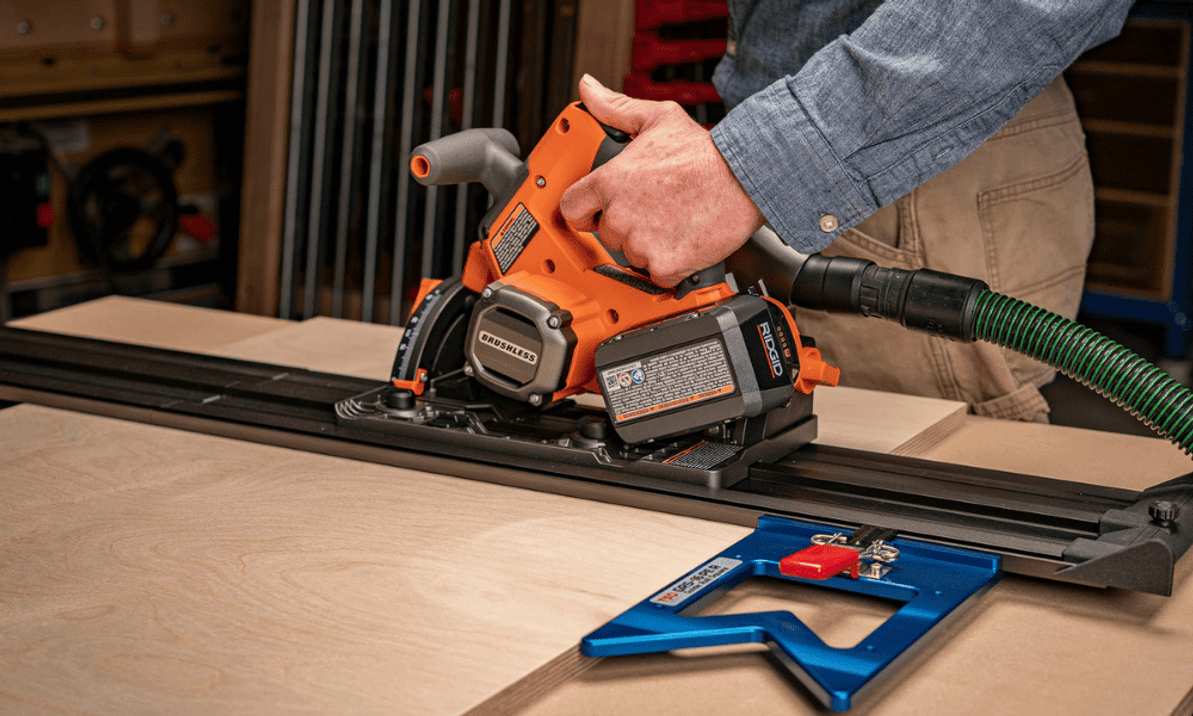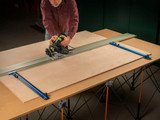Workshop Dust Collection: Smarter Setups for Safer Shops
Wood dust is more than just a nuisance—it’s a real hazard. While sweeping up chips might seem like the main concern, the fine airborne dust is the biggest threat. These particles are small enough to linger in the air and reach deep into your lungs, and over time, that exposure can have serious health consequences. Respiratory irritation, reduced lung function, and even cancer have all been linked to prolonged wood dust inhalation.
The good news? A well-designed dust collection system can drastically reduce airborne particulates, keep your shop cleaner, and extend the life of your tools. Whether you’re running a full-size cyclone or just wheeling a shop vac from tool to tool, optimizing your setup doesn’t require a full overhaul—it starts with understanding how airflow works, where your system falls short, and which upgrades offer the biggest return.

Shop Vacs vs. Dust Collectors: Understanding the Tradeoffs

Most hobbyists start with a shop vac, and for good reason. They’re affordable, portable, and provide strong suction, perfect for small tools like sanders, trim routers, or drilling operations where the dust stays close to the source. Shop vacs excel at static pressure, which means they’re good at pulling dust through narrow hoses and restrictive ports.
Portable shop vacs can capture fine dust, with certain caveats. Their lower airflow (CFM) limits their effectiveness in capturing fine dust at the source—especially from tools that produce a lot of airborne particles. To improve performance, selecting a vacuum with HEPA filtration (or adding a HEPA-rated bag if available) is essential, but for whole-shop dust control, a dedicated cyclone dust collector is far more effective.
But when it comes to high-volume dust producers—like planers, jointers, band saws, or router tables—shop vacs simply fall short. These tools generate more chips than a narrow hose can handle, and they require higher airflow (measured in CFM) to effectively capture dust at the source. That’s where dust collectors come in.
Dust collectors move large volumes of air through larger hoses, typically 4–6 inches in diameter. They’re designed for big tools and permanent setups, often paired with blast gates to control flow across the shop. While they don’t have the suction force of a shop vac, they make up for it by moving a lot more air, and that’s what clears dust from larger areas and cabinets.
Between shop vacs and full-size dust collectors lies a growing category of hybrid, semi-stationary dust collectors—units like the Oneida Mini Gorilla or other portable cyclones. These systems offer a sweet spot for many hobbyists: they’re mobile enough to move from tool to tool, yet powerful enough to deliver high CFM through 4-inch hoses, making them far more effective than a typical shop vac for collecting chips and fine dust alike. Many include built-in cyclones to separate out larger debris before it hits the filter, helping maintain airflow and reduce maintenance. For small to mid-sized shops without permanent ductwork, these hybrid units provide a flexible, high-performance solution—ideal for users who want to upgrade from a shop vac without committing to a full-blown central system.
The takeaway? Shop vacs are best for portable use and small tools. Full-size dust collectors are essential for stationary machines and high-volume work. And hybrid units—like portable cyclones—offer a powerful middle ground, delivering high airflow in a mobile package. Most well-equipped shops end up using a combination of all three, each in the role they’re best suited for.

Smart System Design Starts with Airflow
A good dust collection system isn’t just about horsepower, it’s about design. The best collector in the world can’t perform if it’s hooked up to a maze of tight turns, long flex hoses, and leaky connections.
Think about the design of your duct runs and how to minimize turns and friction. Flex hose is convenient, but its ribbed interior creates turbulence that kills airflow. Keep lengths short—under eight feet is a good benchmark—and use rigid ducting for the bulk of your runs. SDR35 sewer and drain pipe is a budget-friendly option many woodworkers rely on. If you’ve got the budget, modular metal ducting like Nordfab is even better.
Watch your angles. Two 45-degree elbows are always better than a single tight 90, and “long sweep elbows” are even better still. Every turn and restriction increases static pressure, which reduces the volume of air your system can move.
Blast gates at each tool let you isolate suction where you need it, improving overall performance. And don’t forget the small stuff, air leaks around fittings and gates are more common than you think. A smoke stick or even a lit incense stick can help you identify problem spots.
In short: efficient dust collection starts with efficient airflow. Keep runs short, avoid sharp turns, seal your connections, and make sure your system matches your tools' needs.
Quick System Assessment
Even experienced woodworkers can overlook weak spots in their dust collection. Start with a simple check: are you getting acceptable chip collection at each tool when other blast gates are closed? Are you seeing visible dust during cuts or sanding? If yes, it’s worth digging deeper. For those who prefer numbers, portable anemometers can give you the airspeed at the end of every duct run, helping you pinpoint opportunities for improvement.
Filters are often the culprit behind poor performance. A clogged filter, especially in a cyclone setup, can dramatically reduce airflow. HEPA filters, like those from Wynn Environmental, offer excellent filtration but need accessible filter clean-outs and regular cleaning. Overfilled chip bins can also push debris into filters, clogging them faster.
A quick self-check:
- Long flex hoses?
- Multiple tight bends?
- Leaks at fittings or blast gates?
Each of these can chip away at your system’s efficiency.

Tool-Specific Dust Challenges
Some tools are just harder to manage. Routers, for example, kick dust in every direction, especially during edge profiling or template routing. Using a spinning half-guard around the bit or setting up both above- and below-table collection helps contain the mess.
Bandsaws tend to dump dust beneath and around the table. A brush under the blade and well-placed collection ports (above and below) can help. Miter saws are notorious for poor capture; many woodworkers build “tents” or use large-diameter hoses to improve results.
The goal isn’t perfection - it’s finding practical solutions that yield incremental improvements and make your workspace safer..
Matching System Type to Your Space
In smaller shops or shared spaces, portability matters. A shop vac or hybrid dust collector with a rolling cart and quick-connect hoses lets you stay flexible. For permanent setups, a centralized cyclone with rigid ductwork and remote controls offers better performance, especially if you use high-output tools often.
If you're on a budget, start small: upgrade to a HEPA filter in your current vacuum, or purchase a HEPA-rated vacuum, upgrade your worst offenders, seal your leaks, and add blast gates where needed. Even phased improvements can make a big difference in air quality and cleanup time.
Optimizing Ducting and Airflow
Small adjustments in your duct layout can have a big impact. Stick with 6" ducting where possible (6” ducts move 2.25 times more air than 4” ducts), minimize long runs, and keep your blast gates close to the tools. Avoid unnecessary turns—two 45s flow better than one tight 90—and seal all connections to prevent leaks. Every bit of resistance adds up, reducing your system’s efficiency.
Filtering the Air You Don’t See
A good dust collection setup doesn’t stop at the tool. Fine airborne dust lingers, even with strong extraction. Filters rated for 1 micron or less are essential for health and performance, just make sure you’re maintaining them. Clean them regularly, especially in high-use shops. Ceiling-mounted air filters can also help grab what your main system misses, especially after longer work sessions.
Start Where You Are, Improve What You Can
Effective dust collection doesn't require rebuilding your entire shop overnight. The most significant improvements often come from targeted solutions to specific workflow bottlenecks.
For woodworkers balancing mobility with collection efficiency, our Mobile Dust Collection Cart Plans offer a practical solution. Designed by MWA Woodworks, these plans enable you to build a custom cart that integrates shop vacuum storage, cyclone separation, and tool support in one mobile unit. This approach gives you the flexibility to move high-performance dust collection exactly where you need it, without sacrificing effectiveness or requiring permanent ducting installations, particularly valuable in shared or limited shop spaces.
For users of the Parf Guide System, our UJK Parf Dust Port offers a purpose-built solution to a specific workshop challenge. This accessory provides an effective connection between your track saw and dust extraction system when working with the Parf Guide. Its low-profile design maintains cutting accuracy while significantly improving collection efficiency during guide system operations.
At TSO Products, we approach dust collection the same way we approach all our woodworking solutions—by identifying real workshop challenges and developing practical, precision-engineered answers. Whether it's optimizing your dust extraction setup or improving measurement accuracy, our focus remains on enhancing both the process and results of your woodworking.
The principles of effective dust collection remain consistent regardless of your setup: minimize resistance, maximize airflow at the source, and properly filter the air you breathe. By approaching dust management as an integrated system rather than isolated tools, you'll create a cleaner, healthier, and more efficient workspace that improves both your projects and your workshop experience.
Recent Posts
-
What Size Guide Rail Do I Need? Choosing the Right Length (and When to Use Extensions)
The scenario: you need to make a cut in that full size plywood panel sitting in the corner of your s …6th Nov 2025 -
Best Track Saw Systems: Expert Review & Advice
The track saw market has changed considerably over the past three years. Back then, your options wer …6th Nov 2025 -
Systainer Storage Guide: Organize Your Workshop Tools
Picture this: you're setting up for what should be a straightforward series of cuts, but you can't l …2nd Sep 2025




